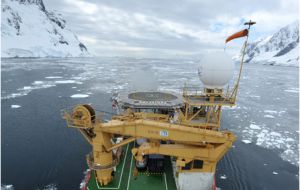MercoPress. South Atlantic News Agency
HMS Protector cuts through Antarctic ice and visits remote research bases
 HMS Protector's journey through the Lemaire Channel, situated along the Antarctic Peninsula, where the ship broke through ice for the first time
HMS Protector's journey through the Lemaire Channel, situated along the Antarctic Peninsula, where the ship broke through ice for the first time HMS Protector, the Royal Navy's ice patrol ship, has cut through the ice floes of Antarctica for the first time. The icebreaker arrived in Antarctica for the first time two weeks ago and is following up important survey work for shipping in the region with visits to remote research bases locked in the frozen continent.
At Deception Island, a stunning water-filled volcanic caldera that is one of just two in the world, Protector sent her smaller survey boat James Caird IV with multi-beam echo sounder equipment to survey the area known as 'Neptune's Bellows'.
It was here that in 2007 the cruise ship MV Nordkapp ran aground and was assisted by the previous ice patrol ship HMS Endurance.
Leading Seaman Chris Smith, the boat's coxswain, said that working on the “Neptune's Bellows survey was a highly satisfying job professionally; being part of a team that worked on something this important to the safety of navigation makes all the hard work of being away from my family worthwhile”.
A team of four spent two nights at an abandoned Admiralty base, braving gale-force winds with 55-knot (100km/h) gusts to both collect information used for chart-making and satellite-positioning and to record the tidal range. The team took precise GPS measurements on land to make sure the tide gauge was level. The information will allow the UK Hydrographical Office in Taunton to produce accurate charts for ships transiting the area.
“The opportunity to survey Neptune's Bellows was fantastic; being able to use the Royal Navy's most advanced survey motor boat and in such a stunning area”, said the officer in charge of the survey boat, Lieutenant Graham Blenkinsop.
”It was even more satisfying to know that the work we were doing will have a direct impact on the safety of the many cruise ships and research vessels that pass through Neptune's Bellows and to know that we have done our part to make such an isolated part of the world safer for the ships and their crews.“
Later, some of the crew of HMS Protector visited the Spanish Antarctic station Gabriel de Castilla, meeting base commander Major Antonio Casals Abraham and his team, who greeted them with a British Union Flag flying next to the Spanish flag on the beach.
After a tour, Lieutenant Commander Andy Storey, Operations Officer on Protector, presented a ship's crest to the base commander and invited him to dinner with Captain Peter Sparkes, Protector's Commanding Officer, and the Commanding Officer of the Spanish Antarctic patrol ship SPS Las Palmas.
It was in the Lemaire Channel that HMS Protector first broke the ice to mark her role as the Royal Navy's ice patrol ship. It took four hours to travel through the passage, with the ice increasing steadily, and seals and penguins on the ice floes.
Protector then moved on to Port Lockroy, a historic British base manned by the UK Antarctic Heritage Trust. She brought vital stock, loaded in Portsmouth, to resupply the base, as well as its Post Office and small shop.
The ship's work boat Terra Nova delivered the supplies and then transferred building waste back to Protector to follow Antarctic Treaty and environmental protocols.
The ship's company visited the museum at Port Lockroy where living conditions from the 1940s and 1950s are preserved with handwritten notes and other memorabilia. Lieutenant Simon Lockley discovered that his namesake Sub-Lieutenant Lockley was one of the first base commanders there 60 years ago.
Meanwhile, for three days, Protector deployed her cold weather experts, the Royal Marines, to complete their cold weather training.
”The environment in Antarctica offers a unique challenge. We are here to provide the appropriate level of expertise to the ship's company and these few days ashore have helped to consolidate our perishable skill set”, said Mountain leader Colour Sergeant Mick Cowe.




Top Comments
Disclaimer & comment rules-

-

Read all commentsWhere's Martin the yank? He was deeply infatuated with this ship :)
Feb 07th, 2012 - 09:10 am 0The Argentines are not a real nation, their country has only existed for about 175 years. Most Argentines trace their family history to Italy, Spain, Germany and the British Isles. The only real Argentines are the Amerindians and their nation is the entire continent of America.
Feb 07th, 2012 - 05:51 pm 0The Argentines I know have Italian mothers, English father, Spanish grandfathers, German grandmothers, Welsh great great uncles. It's technically impossible to claim Argentines are a nation.
They also have the most comically fascist like government on the entire continent. Their entire policy agenda revolves around a group of islands they work 24/7 to alienate the population of. While spreading lies and peddling rants about “the British” that make Mugabe look normal by comparison.
Latin Americans find Argentina an alien culture, its a colonial relic, a piece of Europe transplanted onto a continent thousands of miles away. The culture is Latin European, with a touch of English and Welsh. It certainly bears no resemblance to its neighbors in Paraguay, Bolivia, Venezuela, or Peru.
Even the Argentine honour guards wear colonial uniforms copied from the British and Spanish Imperial era.
They are a throwback to another age. An age of fascism
Commenting for this story is now closed.
If you have a Facebook account, become a fan and comment on our Facebook Page!